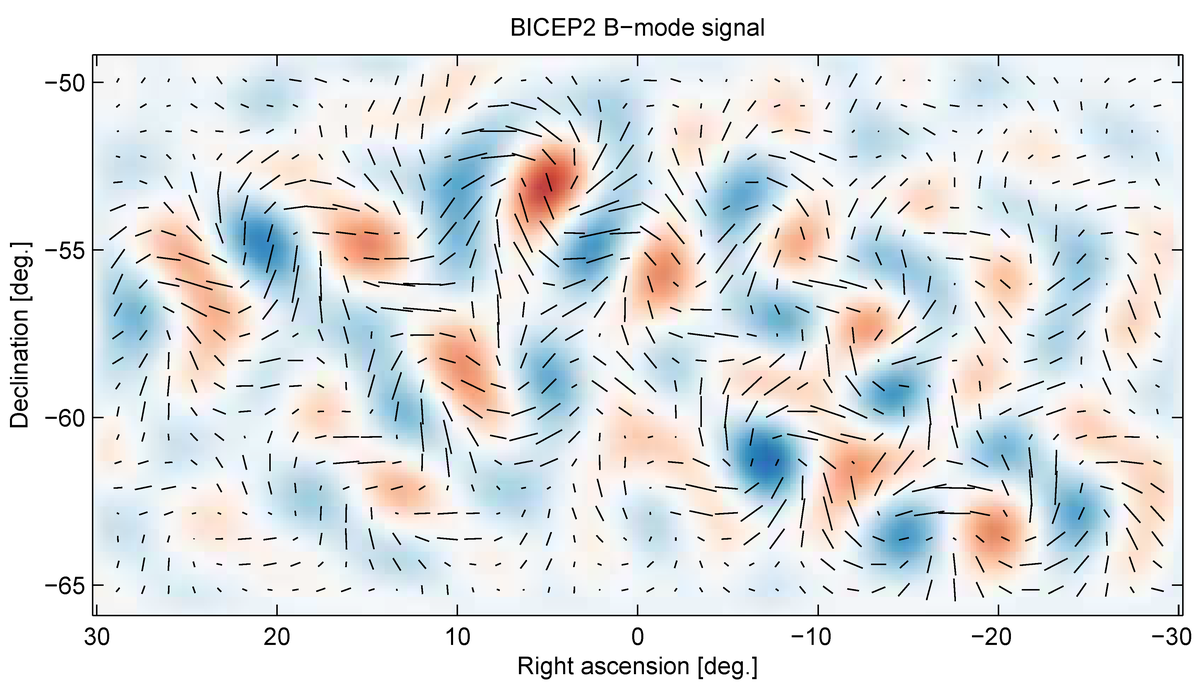The data release page and papers are located at: bicepkeck.org
The primary goal of BICEP2 was to measure the very faint polarization of the cosmic microwave background (CMB). The CMB is a nearly perfect, uniform black body at 2.7 K, with degree-scale temperature anisotropy of about 0.1 mK and polarization on the order of microkelvin. This radiation was emitted 380,000 years after the Big Bang, at the time of recombination, when the Universe first became transparent to light. The temperature anisotropy and polarization of the CMB are some of the most powerful ways of understanding the early Universe. Cosmologists believe the Universe experienced a rapid period of cosmic inflation during its first fraction of a second, exponentially expanding from a dense, hot subatomic volume. Many models of inflation predict that this rapid acceleration would have generated gravitational waves that would remain energetic enough 380,000 years later to leave an imprint on the CMB. BICEP2 targeted this imprint by measuring the pure-curl component of the CMB polarization on degree angular scales, which is largely free of contamination from sources other than primordial gravitational waves.
BICEP2 detected this B-mode polarization in its three year data set with a strong significance. Interpreting this as primordial gravitational waves, this places a constraint on the tensor to scalar ratio at r=0.20+0.07/-0.06. This is strong evidence for cosmic inflation, as well as the first direct image of gravitational waves, and direct empirical evidence of quantized gravity.
BICEP2 maps achieved the unprecedented sensitivity of 85 nK per square degree pixel over an effective area of 400 deg^2. The approach taken in the BICEP/BICEP2/Keck Array/BICEP3 family of telescopes is aimed at increasing the sensitivity of the telescope at the degree angular scales by using cold, refractive optics. All of the optics are cooled to 4K, reducing the optical loading and the noise levels, but limiting the beam size to 0.22 deg.
BICEP2 built upon the success of BICEP1, replacing horn-coupled bolometers with antenna-coupled TES arrays fabricated at JPL. This change allows an increase in the number of pixels, and an improvement in mapping speed of a factor of 10. BICEP2 was deployed in November, 2009, took data through December, 2012 from the Amundsen-Scott South Pole Station, which offers excellent environmental conditions for microwave astronomy.
KIPAC is a participant in BICEP and BICEP2 through the group of Chao-Lin Kuo. The group also actively works on the next generation telescope, the Keck Array, which is observing at the South Pole from 2011-2016 (expected). Our collaborators on BICEP2 are Caltech, JPL, Harvard, Chicago, Berkeley, San Diego, British Columbia, and Toronto.
Click the images below to see a larger version

Gravitational waves from inflation generate a faint but distinctive twisting pattern in the polarization of the CMB, known as a "curl" or B-mode pattern. For the density fluctuations that generate most of the polarization of the CMB, this part of the primordial pattern is exactly zero. Shown here is the actual B-mode pattern observed with the BICEP2 telescope, with the line segments showing the polarization from different spots on the sky. The red and blue shading shows the degree of clockwise and anti-clockwise twisting of this B-mode pattern. Gravitational waves from inflation generate a faint but distinctive twisting pattern in the polarization of the CMB, known as a "curl" or B-mode pattern. For the density fluctuations that generate most of the polarization of the CMB, this part of the primordial pattern is exactly zero. Shown here is the actual B-mode pattern observed with the BICEP2 telescope, with the line segments showing the polarization from different spots on the sky. The red and blue shading shows the degree of clockwise and anti-clockwise twisting of this B-mode pattern.








